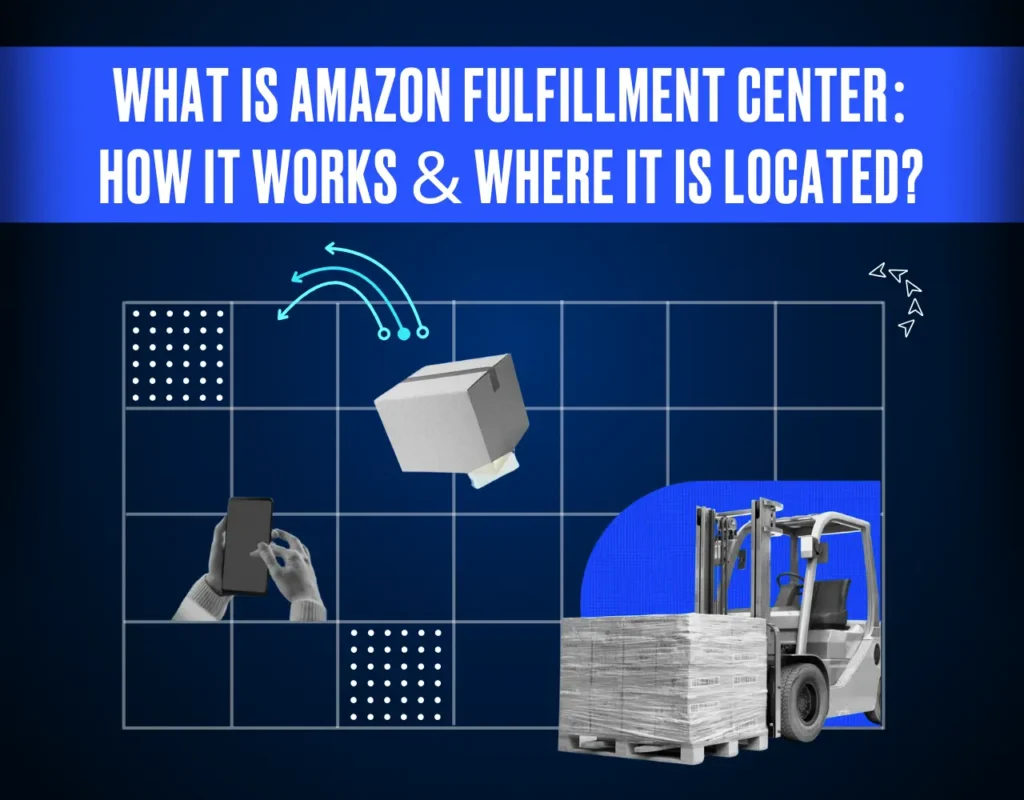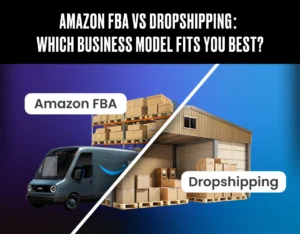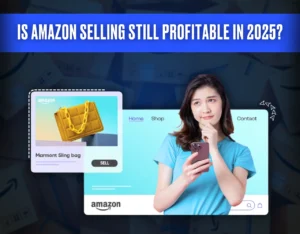An Amazon Fulfillment Center is a place where products are stored, packaged, and shipped to customers on behalf of buyers. It may look like a regular warehouse, but its role goes far beyond simple storage. Fulfillment Centers are intended to manage the entire logistics chain for Amazon’s platform.
Continue reading to understand how fulfillment centers work, what their benefits are, and how much they charge for their services. We’d also share the locations of these fulfillment centers and explain an easy way of sending products there. Let’s head on to the details! An Amazon Seller Central expert can help grow your business.
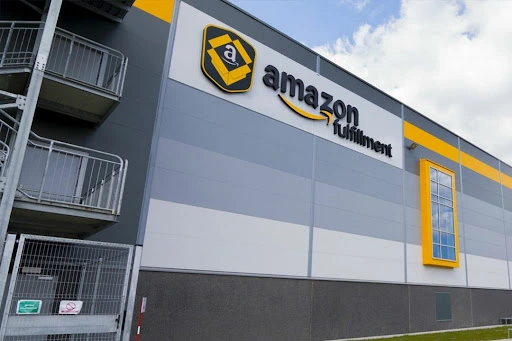
Quick Summary
Before diving further into this guide, here’s a quick overview of Fulfillment centers you should know:
- Products are stored, packed, and shipped to customers from Amazon Fulfillment Centers.
- These centers work on automation. Human staff and robots work together to handle inventory and manage orders.
- There are more than 185 Fulfillment centers worldwide that provide real-time inventory management and ensure fast delivery.
An Inside Look at an Amazon Fulfillment Center
Amazon fulfillment centers are huge facilities where technology and humans collaborate to ship orders effectively. They range from 17 acres or 750K sq ft and name themselves after adjacent airports for convenience. Here’s how these centers use advanced systems to manage operations:
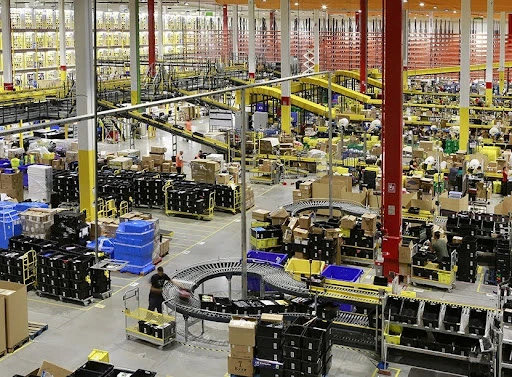
- Scan barcodes and inspect items for damage.
- Keep goods on shelves and keep tabs on their locations.
- Shuffle shelving units with amazon robotic floor systems.
- Handle large products in specialty non-sort areas.
- Allocate packaging with Amazon’s SLAM approach (Scan, Label, Apply, Manifest)
- For efficiency and safety purposes, Amazon builds high-ceilinged, well-lit facilities for associates to park.
How Amazon FBA and Fulfillment Center are Related?
Many novice sellers are not completely familiar with the term FBA. It stands for ‘fulfillment by Amazon’. Through this service, Amazon takes the responsibility of shipping orders to customers.
Moreover, it manages the customer service too. As a seller, all you have to do is send your inventory to one of the fulfillment centers. These centers organize the products, ensure safe packaging, and deliver them quickly.
With hundreds of active worldwide centers, these hubs ensure that the buyer receives the product on the same day or mostly within a couple of days. Different delivery services, such as USPS, work with Amazon fulfillment centers to ensure that the products are delivered to customers smoothly.
How Amazon Fulfillment Center Work?
Until now, we have covered the basics. It’s time to take a deep dive into what services Amazon fulfillment centers provide:
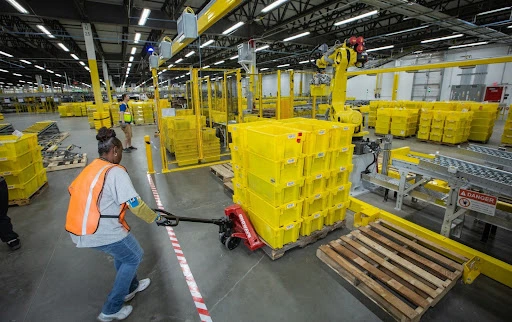
| Step | Description |
| Stock Arrival | Sellers and suppliers receive products at the fulfillment center, where they are inspected for quality. Each product is assigned a unique code so that it can be followed throughout the process. These codes could be Amazon FNSKU barcodes, ASIN, or UPC. |
| Organizing | Products are stored in certain areas depending on the size, category, and demand. Amazon technology assists in categorizing inventory effectively for quick retrieval. |
| Item Selection | When an order is received, staff and robots identify the items with hand-held devices or automated systems, then pick them up for packing. |
| Packaging | Staff package the products carefully, inserting inserts or padding materials where necessary. The system labels packages correctly for shipping. |
| Order Dispatch | Orders are sorted by destination and shipped to carriers like UPS or FedEx. Secure partnerships and advanced logistics guarantee on-time delivery. |
| Returns Management | Returns are also processed through fulfillment centers, inspecting products and deciding whether they should be restocked, recycled, or disposed of. |
Once your products arrive at an Amazon fulfillment center, they are assigned an LPN barcode for better inventory management. Learn about the Amazon LPN barcode system.
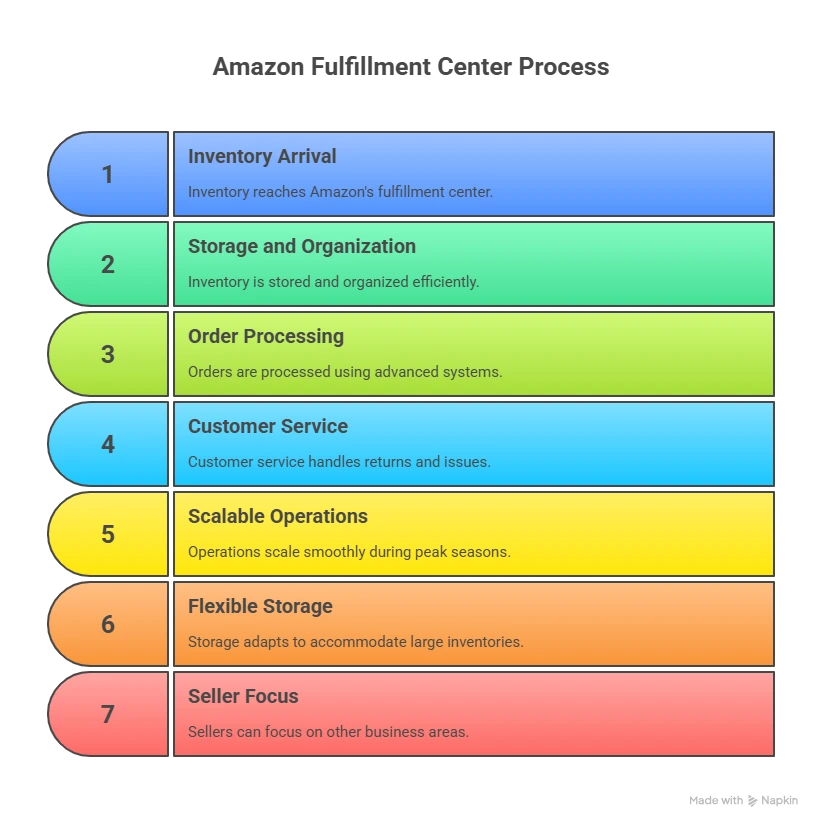
Warehouse vs Fulfillment Center: Are They Both the Same?
Most individuals confuse Amazon warehouses and fulfillment centers, but they have different functions:
| Characteristic | Warehouse | Fulfillment Center |
| Function | Inventory stock products in bulk prior to distribution or sale | Pick, pack, and send single customer orders |
| Inventory Handling | Take care of inventory management and simple order fulfillment | Process inventory in real time and deal with returns |
| Users / Clients | Primarily serve manufacturers, wholesalers, and distributors | Serve e-commerce retailers and direct-to-customer orders |
Also, if you want to learn the difference between Amazon Vendor Central vs Seller Central.
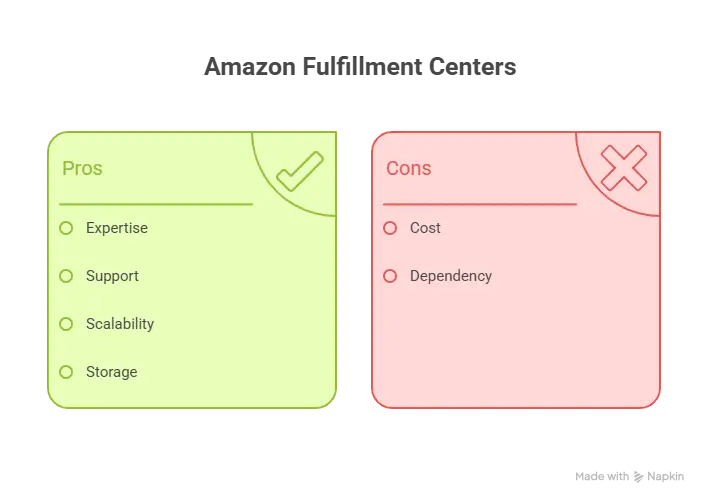
4 Benefits Of Amazon Fulfillment Centers You Should Know
When your inventory reaches their centers, Amazon does all the heavy lifting. Here are the upsides that make these centers a game-changer:
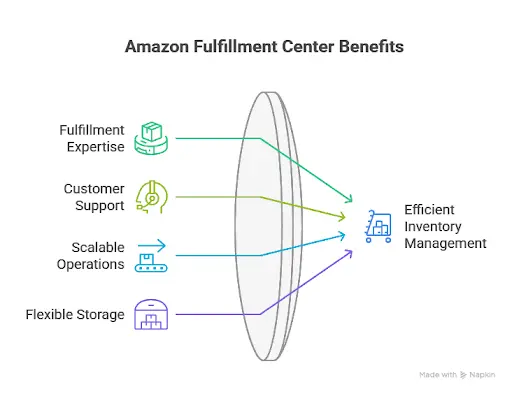
- In-Built Fulfillment Expertise: Advanced systems, robotics, and experienced personnel take care of storage, organize the inventory, and process order-taking in an efficient manner.
- CS Support: Orders fulfilled using the centers are accompanied by consistent handling for returns and order-related problems for smooth operations.
- Scalable Operations: Fulfillment centers can receive different levels of inventory smoothly, ranging from slow seasons to peak periods, without affecting the process flow.
- Flexible Storage Management: All centers can accommodate large amounts of inventory efficiently, using space wisely, and ensuring that products are ready for dispatch at all times.
In other words, these centers will help the sellers to focus on the other areas of the business since they are very scalable, reliable, and efficient. This ease of business allows them to grow in no time and makes FBA worth it.
What Sellers Need to Know About Amazon Fulfillment Center
There are three things that sellers should learn about the Fulfillment Centers:
- Fee Structure,
- License to sell items,
- Key Locations,
- How to send product to fulfillment centers.
If you’re sourcing products from Alibaba and want to learn how to send them to Amazon, our guide on How to sell on Amazon from Alibaba can help.
During my research, I found a Reddit thread where users discussed the difference between a fulfillment center and a distribution center, which adds more clarity to this topic.
Posts from the amazonfc
community on Reddit
1. AMZ Fulfillment Center Fee Explained
Amazon does not disclose all fulfillment center charges, but FBA sellers typically pay a few standard fees:
- Fulfillment Fees: Amazon charges per item. They vary by size, weight, and category. They include picking, packing, shipping, and customer service.
- Storage Fees: Amazon charges a monthly fee for stored stock. Fees can fluctuate during busy or slow periods.
- Extra Charges: Sellers must pay additional fees for returns, removals, or long-term storage.
For FBA sellers, keep in mind the optimum box size limits and requirements to ensure that you don’t overpay.
Even with these charges, most vendors depend on fulfillment centers. These offer exposure to Amazon’s large, highly efficient logistics network. You can learn more about selling models here. Let’s take a look at some pricing details!
| FBA Fee For Non-Apparel | |||
| Size tier | Max dimension | Shipping weight | Fulfillment fee |
| Small standard | 15″ 12″ 0.75″ | 4 oz or less | $3.22 |
| 4+ to 8 oz | $3.40 | ||
| 8+ to 12 oz | $3.58 | ||
| 12+ to 16 oz | $3.77 | ||
| Large standard | 18″ 14″ X 8″ | 4 oz or less | $3.86 |
| 4+ to 8 oz | $4.08 | ||
| 8+ to 12 02 | $4.24 | ||
| 12+ to 16 oz | $4.75 | ||
| 1+ to 1.5 lb | $5.40 | ||
| 1.5+ to 2 lb | $5.69 | ||
| 2+ to 2.5 lb | $6.10 | ||
| 2.5+ to 3 lb | $6.39 | ||
| 3+ lb to 20 lb | $7.17 $0.16/half-lb above first 3 lb | ||
| Small oversize | 60″ 30″ | 70 lb or less | $9.73 $0.42/lb above first lb |
| Medium oversize | 108* (longest side) | 150 lb or less | $19.05 $0.42/lb above first 1b |
| Large oversize | 108″ (longest side) | 150 lb or less | $89.98 $0.83/lb above first 90 lbs |
| Special oversize | >108″ (longest side) | Over 150 lb | $158.49 $0.83/lb above first 90 lbs |
| FBA Fee For Apparel | |||
| Size tier | Max dimension | Shipping weight | Fulfillment fee |
| Small standard | 15′ x 12″ x 0.75″ | 4 oz or less | $3.43 |
| 4+ to 8 oz | $3.58 | ||
| 8+ to 12 oz | $3.87 | ||
| 12+ to 16 oz | $4.15 | ||
| Large standard | 18″ 14″ x 8″ | 4 oz or less | $4.43 |
| 4+ to 8 oz | $4.63 | ||
| 8+ to 12 oz | $4.84 | ||
| 12+ to 16 oz | $5.32 | ||
| 1+ to 1.5 lb | $6.10 | ||
| 1.5+ to lb | $6.37 | ||
| 2+ to 2.5 lb | $6.83 | ||
| 2.5+ to lb | $7.05 | ||
| 3+ lb to 20lb | $7.17 $0.16/half-lb above first 3 lb | ||
| Small oversize | 60″ 30″ | 70 lb or less | $9.73 + $0.42/lb above first lb |
| Medium oversize | 108″ (longest side) | 150 lb or less | $19.05 $0.42/lb above first lb |
| Large oversize | 108″ (longest side | 150 lb or less | $89.98 $0.83/lb above first 90 lbs |
| Special oversize | >108″ (longest side) | Over 150 lb | $158.49 $0.83/lb above first 90 lbs |
| FBA Storage Fees | ||
| Month | Standard size | Oversize |
| January – September | $0.87 per cubic foot | $0.56 per cubic foot |
| October – December | $2.40 per cubic foot | $1.40 per cubic foot |
Many sellers also use the Amazon retail arbitrage model, sending inventory to fulfillment centers for faster delivery. This helps them to buy at a low cost and sell at higher margins for a better profit ratio.
2. Where are Amazon Fulfillment Centers Located?
Amazon has a huge delivery network. In the US alone, the organization operates more than 110 centers, with the most located in Florida, Texas, and California.
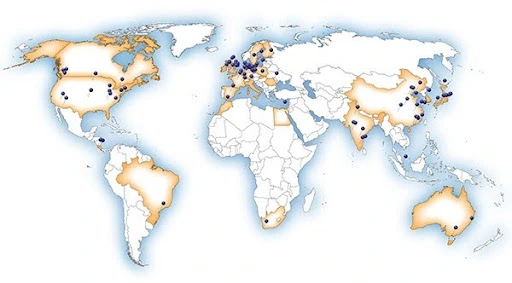
The company boasts over 185 fulfillment centers throughout the world. They are located in such a way that product delivery can be made in the shortest time possible.
If you’re curious about competitors, check how to find someone’s Amazon storefront to see who is also using FBA. Now, let’s explore the Amazon Fulfillment Center Locations:
| Amazon Fulfillment Centers – US | ||
| State | Facility Code | Location |
| Arizona | PHX5 | Goodyear, AZ |
| California | ONT3 | San Bernardino, CA |
| California | OAK5 | Newark, CA |
| Florida | MCO5 | Davenport, FL |
| Florida | MIA5 | Doral, FL |
| Texas | DFW6 | Coppell, TX |
| Texas | HOU1 | Humble, TX |
| Washington | SEA6 | South Seattle, WA |
| Washington | BFI5 | Kent, WA |
| Amazon Fulfillment Centers – Canada | |
| Facility Code | Location |
| YVR2 | Delta, BC |
| YYZ1 | Mississauga, ON |
| YUL2 | Lachine, QC |
| Amazon Fulfillment Centers – United Kingdom | |
| Facility Code | Location |
| LTN1 | Ridgmont, Bedfordshire |
| MAN1 | Altrincham, Manchester |
| BHX2 | Ellistown, Coalville |
| LCY2 | Tilbury, London |
You can also consult the Tinuiti guide for more details about the locations.
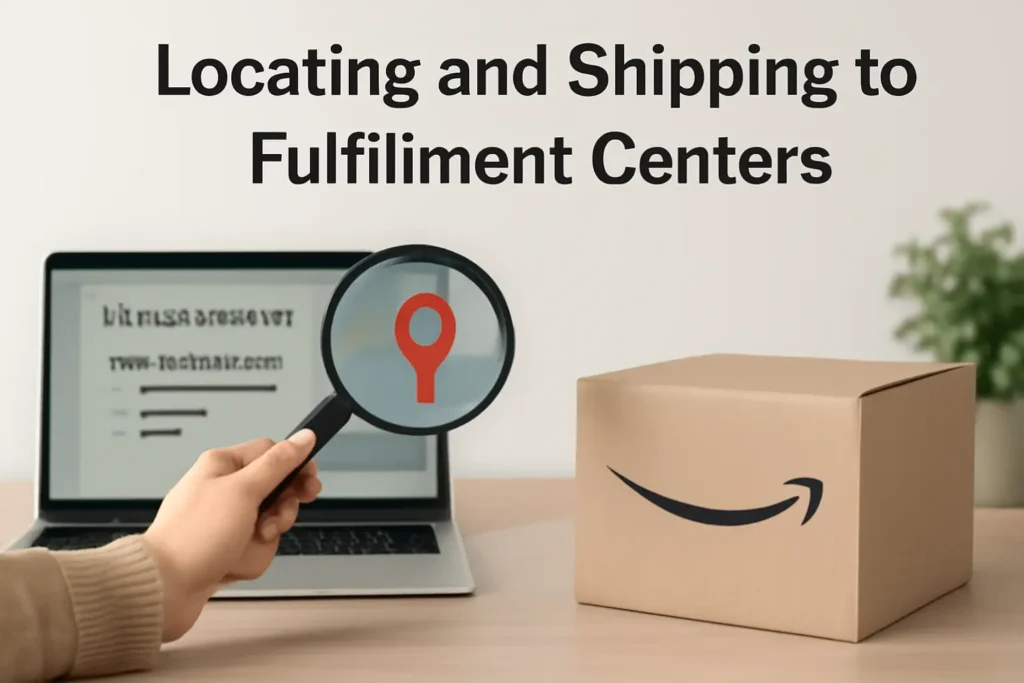
3. Locating Nearest Fulfillment Center and Sending Products There
Sellers can find the nearest Amazon fulfillment center by checking the shipping details of the received order, tracking info, or noticing which center is the fastest to ship the item. One more thing that can help is using the Zip Code. Sellers can find it easily in their Seller Central or FBA shipping workflows. Local news may cover the area of the new fulfillment centers opening up.
Once you confirm the centre, you can send your products there easily by following these steps.
- Start with a Shipping Schedule: Start by planning the shipping of your products to Amazon.
- When selling a Private Label product, first list your product in Seller Central > Inventory > Manage Inventory > Add a Product. Complete the listing by filling in all relevant details.
- Go to Manage Inventory > Check the boxes of the products > Select Send Inventory. You have the option to create a new shipping plan or to add to an existing one.
- Provide the address where your products will ship from. Use the email associated with your home, business, or supplier. For foreign products, fill in the manufacturer’s address.
- Choose one of these two Packing types. Individual Products( assorted in a box) and Case Packed Products(Same Product packed in a Box). Arbitrage sellers generally use Individual Products, while Private Label vendors use Case-Packed to ship their products.
FAQs
What automation does Amazon use?
Amazon fulfillment center automation includes robotics and artificial intelligence for product management and fast order delivery.
Does fulfillment include delivery?
Yes, fulfillment includes order delivery. It consists of all the operational processes covering order receiving, packaging, and delivering to customers.
How do I know if my order is fulfilled by Amazon?
You can confirm the fulfillment of an order by looking for a logo on the package stating, ‘fulfilled’. Plus, you can also find the items sold and shipped by Amazon by checking the seller details on the page or using the Amazon search filters.
Conclusion
Let’s finalise our discussion on What is Amazon Fulfillment Center. It’s a specialised hub owned by Amazon for order management. All the vital steps are performed here, including product storage, packaging, and delivery.
These centers are different than typical warehouses because they process inventory in real time and also manage returns. There are more than 185 Amazon centers across the globe that ensure the fastest product delivery and reliable customer support.

